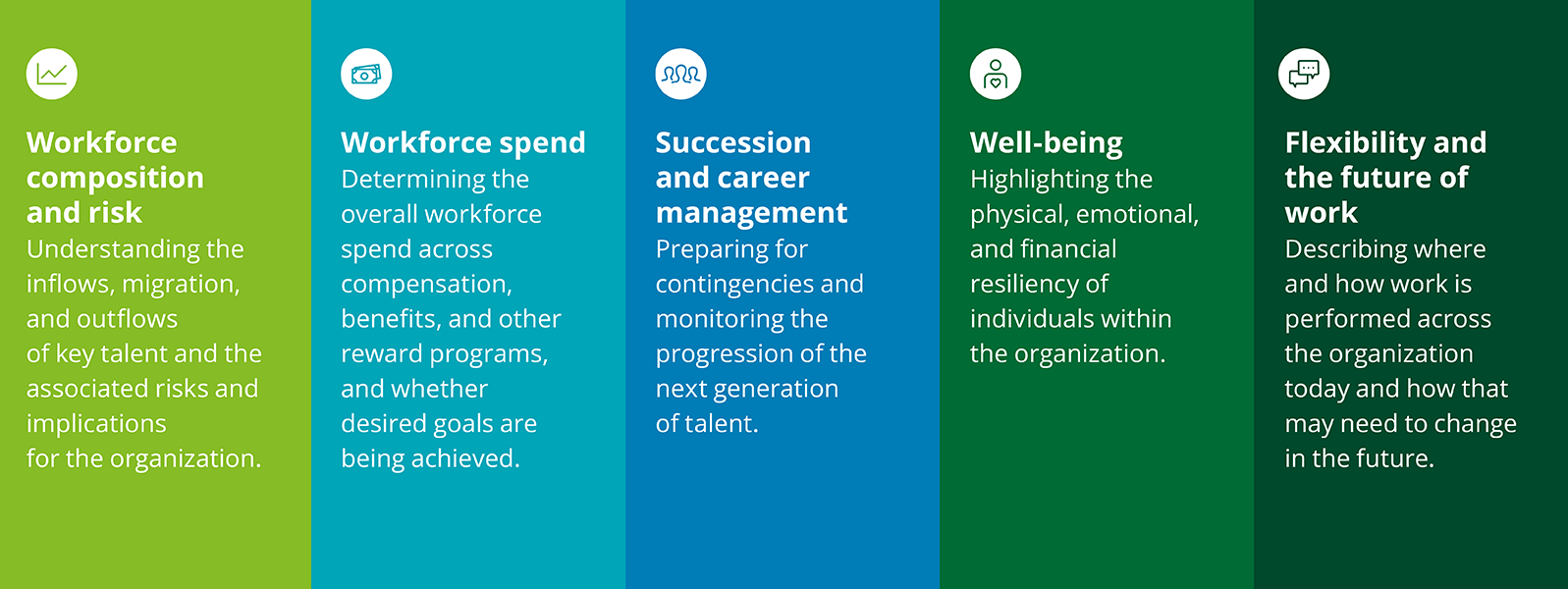Key HR metrics for chief human resources officers has been saved

Perspectives
Key HR metrics for chief human resources officers
Five insights to maximize HR data and people analytics
The life of a chief human resources officer (CHRO) isn’t easy. One of the biggest challenges is having access to key HR metrics, data, and analytics—all crucial for driving important decision-making for the organization and its people. Learn about the five critical areas every CHRO needs insights on to propel their workforce forward.
The challenge of accessing HR metrics, data, and analytics
More than one chief human resources officer has walked away from their CEO’s quarterly business review with a sense of frustration and envy. Having watched the chief financial officer engage the senior leadership team in a spirited discussion about financial performance and insights, the CHRO is often left wondering why they don’t have the same quality and consistency of data—and the same depth of analysis—as their counterparts in finance, supply chain, customer, sales, and marketing functions.
HR organizations often struggle with defining, organizing, and embedding key metrics, analytics, and insights into the larger decision-making processes of their organizations. This is due to many factors—from a lack of data standards to disparate systems that produce inconsistent metrics, to a shortage of analytical skills and capabilities needed to interpret data, identify trends, and translate them into digestible insights that tell a compelling story. As a result, CHROs often find themselves at a disadvantage when using workforce data to influence key decisions within their organizations.
Five key areas of insights and metrics for CHROs
There are five critical areas where CHROs need access to key HR metrics, data, and insights on demand to provide a snapshot of the current state of the work, workforce, and workplace:

Taking a deeper look into these areas, we examine the key HR metrics, types of segmentation and analysis to support the “drill down,” and the practical realities that come into play when trying to build and implement these analytic capabilities within an organization.
While there will be variations depending on your industry and the priority issues facing your organization, these five areas represent a foundational capability we believe every senior HR leader should have. Some of the metrics within these five groups may already exist within your organization. However, from our experience, it is rare for a CHRO to have all of these in a single platform that is easy to use, understand, and share with others in the organization.
In many HR organizations, this is the starting point for the discussion around key human capital metrics. At the highest level, this includes a basic awareness of the current size of the workforce, the mix between employees and alternative sources of talent, the diversity of the workforce, and the overall managerial span of control. These standard metrics can anchor the discussion and should highlight major changes due to acquisitions, divestitures, reductions in force, and other major corporate events. Following this is a greater understanding of talent inflows through an examination of key talent acquisition metrics, which includes an analysis of how many positions remain open, how long it takes to fill those positions, how many people are applying for positions, and how many are accepting offers that have been made. An element of this analysis should also address trends in the number of positions that are filled by internal vs. external candidates.
On the other side of examining talent inflows is an understanding of talent outflows and the drivers associated with it, including measures of overall attrition (voluntary and involuntary), retirements, early departures (e.g., those leaving the organization within one year of hire), and the overall cost to replace individuals (including recruitment, onboarding, and productivity costs).
Surrounding all of this is the concept of managing workforce risks both internally and externally, which could impact the organization’s financial, operational, reputation and brand, and regulatory and compliance outcomes. According to a recent study, 52% of C-suite, executive leaders, and board members said workforce risk is on their board agendas.1 Top workforce risk indicators include succession planning efficacy, workforce planning accuracy, and labor cost per worker.
For most organizations, total workforce spend and understanding the return on investment of your workforce investments are challenging to measure, but when done well they can help your organization make more informed decisions about where dollars are allocated to drive employee brand, value, and sustained profitable performance.
Understanding the various categories of workforce spend, such as salary, variable compensation, overtime, benefits, equity, and other rewards, forms a baseline to determine whether the company is spending its resources according to expectations and market conditions. Senior executives will often want to know how compensation and benefits trends are changing, in terms of both internal comparisons (e.g., are we paying new hires more than the average salary of individuals in similar positions) and external benchmarks across competitors and local labor markets.
From a benefits perspective, it is increasingly important not only to look at how much various programs are costing the company and actual usage of benefits, but also to be aware of individual preferences and sentiment toward different benefits offered. Without this knowledge, the organization may be spending limited resources on benefits that provide little or no value to the workforce and may be missing key benefits that could have a direct impact on key HR metrics, such as workforce engagement and retention.
Regardless of the scope and the processes used for succession planning, from a risk management perspective, organizations should regularly be aware of their ability to backfill key roles. These roles should include senior leaders and individuals in unique jobs that disproportionately impact an organization’s success. Key HR metrics in this category include an understanding of the percentage of roles with succession plans, the number of candidates who are ready and available to step into these key roles, and the extent to which roles are filled by candidates from a defined succession pool.
Executives also need to understand the informal roles individuals play and how their presence (or absence) can affect communication and knowledge-sharing patterns across the organization. Tools such as organizational network analysis can help identify individuals who play central roles in connecting disparate groups and brokering internal and external relationships. Using these tools, companies can identify not only those who contribute to disproportionate results, but those whose unique relationships enable others to be successful as well.
From a larger career management perspective, an organization should also be aware of the percentage of individuals who have been promoted within a given time period. This can indicate the extent that the company is filling opportunities from inside as well as outside the organization. Further, looking at the results of employee engagement scores and comments regarding career and skill development opportunities, as well as managers’ ability to support career progression efforts, can provide important insights into whether individuals believe the organization is supporting their desire for advancement.
Employee wellness continues to be an area that is attracting increased scrutiny in many organizations. Given the need to retain critical workers, organizations are looking to better understand what drives, and supports, employee well-being across six different dimensions, including physical, mental, social, financial, growth, and purpose.
HR metrics that organizations could look at to identify employee wellness concerns vary across these dimensions. For example, understanding absence rates and the extent to which individuals are using (or not using) their paid time off or how many unread emails they have can indicate potential signs of burnout. Statistical relationships across these metrics, combined with employee perceptions regarding their work environment gleaned from workforce listening approaches, can identify areas of stress that could have an adverse impact on the workforce.
The past several years have shown the critical nature of understanding the intersection of work, the workforce, and the workplace in both physical and virtual environments. Debates regarding the effectiveness of hybrid environments and the circumstances in which virtual versus in-person work is necessary for success need to be fueled by an understanding of where and when individuals are working, how they spend their time, how they interact with each other, and how they use their physical and virtual tools.
From a leadership standpoint, HR executives need to be aware of basic measurements such as the number of days that individuals are in the office, the types of workspaces they use, and the number of days/nights they are traveling. More advanced tools capture data regarding the number of virtual meetings, the number of individuals attending, and the length of time they are spending in those meetings. Again, employee perception data also plays a key role in determining whether individuals believe their current work environment enables them to deliver on their expected roles and responsibilities.
Endnotes
1 Joseph B. Fuller et al., Managing workforce risk in an era of unpredictability and disruption, Deloitte Insights, 2023.
Recommendations
Managing workforce risk in an era of unpredictability and disruption
Talent can be an organization’s greatest strength and one of its most challenging assets. What are leading organizations doing to manage workforce risks?
The leader’s field guide to enabling better work, workforce, and workplace decisions
Make smarter decisions with the human capital insights you need




